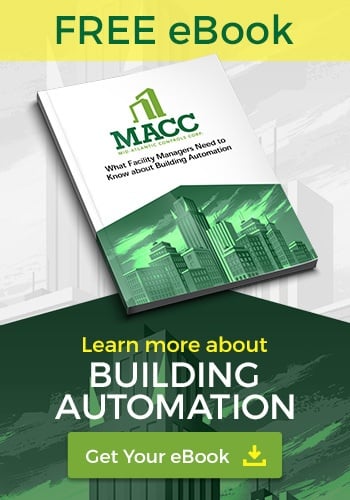
If you’re a property management group trying to make your commercial or residential stock more profitable, you’re probably already on the lookout for better ways to control your costs while adding features that current or future tenants will value.
Today, a new generation of smart devices is making it easier for your building’s management system (BMS) to monitor and optimize your building’s performance while helping to spot potential problems sooner by leveraging the power of the “Internet of Things” (IoT).
In this blog, we uncover what the IoT is and how it works. We’ll also look at eight smart building use cases where IT-enabled BMS devices are already helping to power a range of cost-controlling and profitability-boosting applications.
Raising the Ceiling: 8 Smart Building IoT Applications
The widespread availability of IoT devices makes it easier to roll out enhanced smart building functionality across your existing stock. And this can put more cost-cutting control and many revenue-boosting features at your fingertips. Here’s how:
IoT devices come with a built-in ability to connect with and communicate across your existing internet infrastructure. Instead of needing a dedicated network for each separate system in your building management system (BMS), IoT devices are designed to “plug and play,” using a standardized set of communication and security protocols.
That makes it easier to gather information from many types of sensors or monitoring devices as well as use this information to control and manage the operation of a wide range of building management devices.
How Does the IoT Work?
Strictly speaking, an IoT device is anything that can connect to your building’s Wi-Fi or local area networks using a standard IP (Internet Protocol) address. By doing so, the IoT device is able to share information with other devices or controllers elsewhere on your network (or, for that matter, anywhere in the world).
Today, IoT devices include everything from doorbell cameras to HVAC thermostats. They can even be as simple as individual light bulbs or door locks. In each case, the individual addressability makes it possible for the device to provide information and receive instructions from any other connected device that has this address.
The IoT and Your BMS
IoT devices are driving a new wave of smart building automation by making it possible for different types of devices to work together to share information, either with a central unit managing one or more building systems or directly between local sensor and control units.
This is bringing down the cost of installing or upgrading BMS systems because each separate system controlled by your BMS no longer requires a separate data network to control it. The standardized protocols also sometimes make it easier to integrate older or “legacy” equipment with newer control systems.
This in turn can enable a lot of clever functionality like doors or lights that your tenants can control from their smartphones. But IoT-driven smart functionality also has real implications for your bottom line.
Let’s take a detailed look at eight specific ways that IoT-enabled devices can help enhance the profitability of your building, either by improving your ability to control and reduce overheads and other operating costs or by adding features or services that current or future tenants will be willing to pay for.
1. Optimized HVAC and Lighting Systems
By connecting motion sensors that detect occupancy in real time to HVAC thermostats and lighting systems, you can activate areas of your commercial buildings as and when they are needed. You’ll keep tenants more comfortable in the areas they are using while saving money on heating and lighting in unused areas.
Connecting real-time occupancy sensors to your access control system or even to your tenants’ scheduling software allows you to further optimize your energy spend, while smart temperature sensors compensate for seasonal or daily temperature fluctuations to deliver real savings.
The result? Monthly and year-on-year energy bill savings that translate into added value for owners and investors and add value for tenants.
2. Better Building Security
IoT technology means your access control systems, security cameras, motion detectors, and door locks can now all be connected on a single system rather than each requiring a separate, dedicated network.
That makes it easier to control exactly who has access to your property and for your security staff to track and manage potential threats. This means better protection of your property and your tenants ‘assets across all your properties, reducing losses and associated costs, such as on-site security and insurance premiums.
You can also connect your IoT-enabled system with your corporate tenants’ registered user logs. For residential buildings, you can enable access through all-in-one smartphone apps that regulate building access, as well as “add-ons” like access to delivery or bike storage lockers.
By investing in convenience and value-added services that your tenants will appreciate, you’ll be able to add to the value of your leased properties.
3. Enhanced Environmental Controls
Smarter, more connected building management systems allow you to take environmental control of your building beyond simply regulating heating and lighting systems.
IoT-enabled sensors, timers, and motors can be installed to vary the geometry of solar arrays for maximum sun-tracking efficiency. Similar systems can adjust window shading throughout the day to maximize natural lighting while minimizing glare and direct sunlight.
You can also add fine-grained humidity control to your system, so moisture levels are maintained where they are needed for added comfort.
You’ll see direct savings on your energy bills by making the most of installed solar capacity and natural heating and lighting of your buildings. You’ll also see the indirect benefits of transforming your building into a more pleasant place for your tenants to live or work.
4. Improved Water Management
After power, water is likely one of the biggest overheads either for you or your tenants. Smart water management can help you cut costs and improve profitability.
Water is expensive to heat up but relatively cheap to maintain at temperature. IoT-enabled thermostats on water heaters can be set to a lower temperature in smaller-demand or off-peak time frames.
Sensors that monitor flows from heaters, storage tanks, or even individual toilets, can detect plumbing leaks quickly and shut off the supply, thereby limiting water damage and containing costs if a leak occurs when a building is unoccupied.
What’s more, smart irrigation systems can help control your landscaping costs by irrigating at night or during cooler periods. More advanced systems can increase watering times as temperatures rise.
5. Increased Remote Capabilities
With more and more businesses shifting to hybrid work schedules, both offices and homes need to be set up better to manage remote working. IoT-enabled technology can help your BMS adapt.
While IoT systems may already be enabling 24-hour access to your facilities, allowing your corporate tenants to provide remote “as-needed” access to the building as well as book parking spaces and conference rooms ahead of time can help cut costs and protect profitability at a time when many businesses are reducing their footprints.
Allowing residential clients to open doors for workmen or deliveries or to activate heating or air conditioning remotely is also a valuable convenience for today’s on-the-go lifestyle.
6. Lower Replacement Costs
IoT devices are also generally cheaper and easier to replace. This is because IoT components are more likely to be generic parts designed to provide a specific function for a wide range of applications. As a result, IoT-based BMS are cheaper to install and operate.
By providing a standardized way for devices to connect and communicate, the IP protocol makes it possible to replace many types of specialized devices, as well as reduce the need for dedicated networks to connect them.
7. More Predictive Maintenance
IoT sensors collect information about how well critical devices in your BMS are operating. This data can help you track the operating hours of heat pumps and on-demand equipment like compressors so that maintenance stays on schedule.
Alternatively, you can use performance information to predict and schedule maintenance to maximize equipment life and minimize systems’ downtime. In some cases, you can even spot potential problems early on and then intervene to prevent equipment damage and limit disruption for your tenants.
8. Greater Sustainability and Compliance
The fine-grained data your BMS collects from IoT sensors also provides valuable information about the sustainability of your building and its operations.
Data from multiple sensors can help you measure the impact of, for example, improving the insulation in part of a building, providing actionable information on how rolling out similar upgrades will affect energy savings on other buildings.
Real-time data on how your BMS is helping reduce energy costs can minimize your tenants' carbon footprints. It can also help you comply with local environmental regulations and potentially help you qualify for tax credits or rebates.
Choose a Smart BMS Supplier for Smart IoT Results
IoT systems can unlock real gains in profitability from your managed properties, but only when they are properly installed and managed. It’s important to choose an equipment supplier with the skills and know-how to deliver a system that realizes both bottom-line savings and the added-value features and services your clients expect.
Look for an equipment provider who can design, install, and support a BMS that meets your needs as a property manager. Your supplier should be able to customize a solution that delivers measurable improvements in affordability and can scale implementation to your company’s budget, current needs, and future plans.
Your supplier should have a thorough understanding of how to roll out IP-based IoT technology. It’s just as important that the company you choose also understands how to integrate IoT technology with existing or legacy proprietary BMS gear. This can help you unlock maximum return on your existing investments in BMS capabilities.
The MACC Difference
At MACC, we have been designing, installing, and maintaining robust, open-source BMS systems for decades. We’re skilled at delivering the best IoT platforms for smart buildings and integrating the latest IoT technology with your existing building automation systems.
We can help you get more out of your commercial and residential properties by improving energy efficiency, lowering operating costs, and delivering value-added services that your tenants will appreciate.
We can also help you right-size your investment to improve the value of your properties. Plus, we provide the training and ongoing support you need to improve sustainability and environmental compliance, so you can turn monthly gains into long-term wins for you and your tenants.
Contact us today for a free consultation, or click below to learn more about how better building automation and management systems can benefit your property management company.














